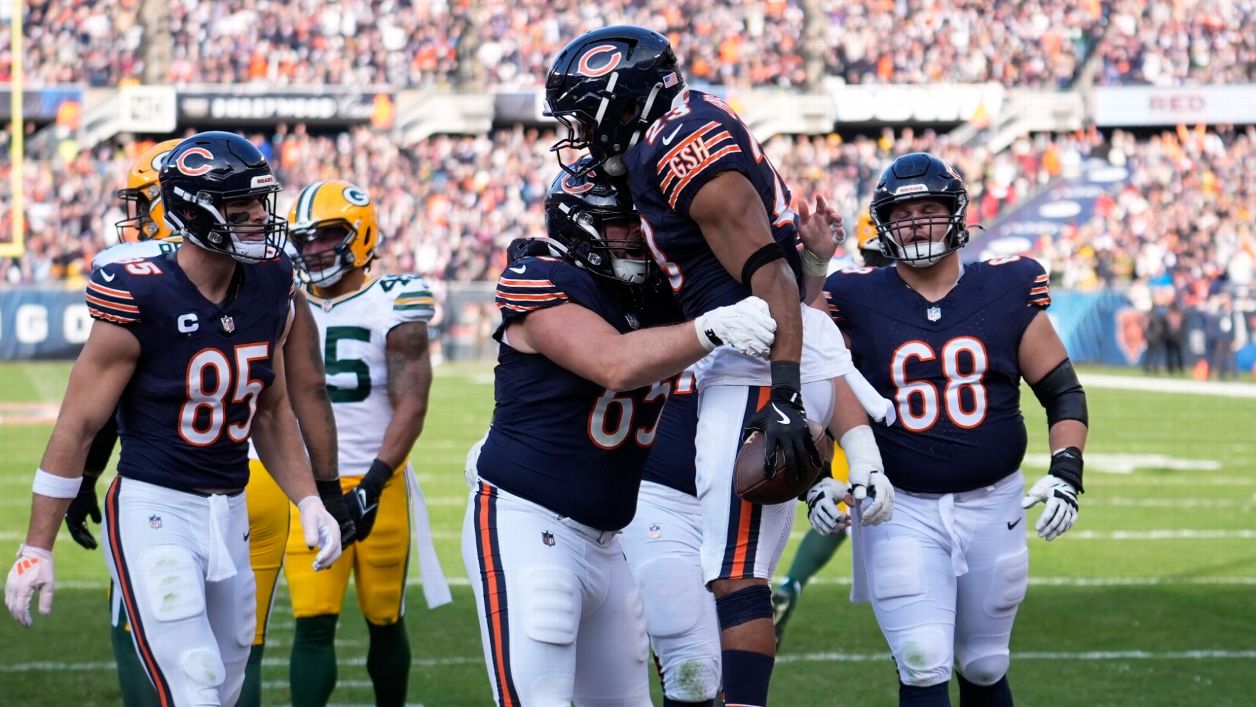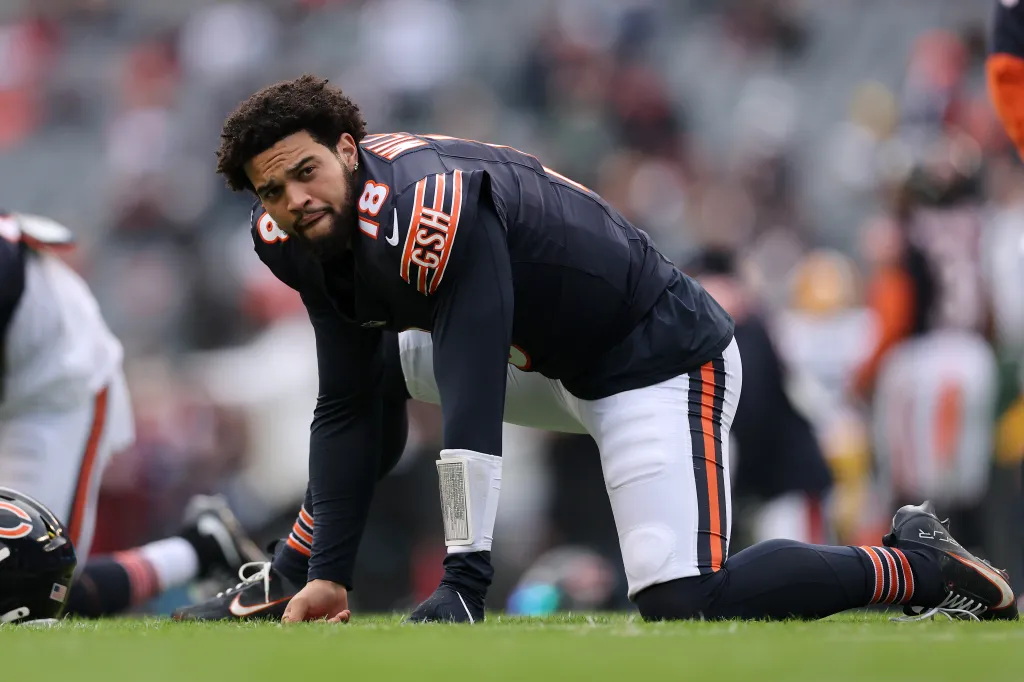On his very first play against the Green Bay Packers, Caleb Williams took his position in the shotgun formation.
Running back D’Andre Swift lined up to his left, while wide receiver Rome Odunze stood to his right in the backfield. Moments before the snap, wide receiver DJ Moore went into motion.
Williams then handed the ball to Swift, who pushed forward for a 2-yard gain. The drive, while modest, advanced far enough to set up a 53-yard field goal attempt.
From the coaches’ box, however, offensive coordinator Thomas Brown had a different perspective on that initial play.
The Bears had promoted Brown from passing game coordinator just four days earlier after firing Shane Waldron. Brown saw the first scripted play as a chance to send a message—not only to his players but also to the opposing Packers.
“Build tendencies to break them,” Brown explained in a phone interview with Yahoo Sports on Tuesday. “Give the same presentation and then still present something different to the defense.”
After that first play, the offense ran 10 more plays, with Williams methodically targeting his top three receivers and his running back.
Brown’s strategy aimed to involve as many players as possible early in the game while also allowing Williams to use his mobility more effectively than in previous weeks.
With 2:23 left in the first quarter and a second-and-5 situation, the Bears returned to a similar formation. Once again, Williams lined up in shotgun, flanked by Swift and Moore.
This time, the formation was flipped: Odunze positioned on Williams’ left, Swift on his right, and Moore in motion—this time from the opposite side.
But instead of handing the ball to Swift, Williams executed a jet sweep, pitching the ball to Moore, who raced 2 yards to the left sideline for a first down.
Though the Bears were on a four-game losing streak, their offense showed flashes of potential. Williams hadn’t thrown or rushed for a touchdown during that span, and it had been more than a month since the Bears scored 20 points in a game.
Even with a heartbreaking 20-19 loss to the Packers—Chicago’s 11th consecutive defeat to a division rival—there were reasons for optimism.
On the final drive, Williams brought up his play, and the offensive strategy under Brown’s guidance appeared significantly smoother. The Bears began to wonder if they had found the blueprint for a turnaround.
In his first game with Brown calling plays, Williams completed 20% more passes than in his previous three outings.
The 2024 first overall pick also recorded his quickest average release time of the season at 2.42 seconds. Under Brown’s direction, he experienced his lowest pressure rate in both raw numbers and percentage.
After struggling with a completion rate below 54% for three consecutive games, Williams hit 74.2% of his passes against the Packers.
At 4-6, the Bears’ playoff chances are slim, with ESPN’s model giving them just a 1% shot in the hyper-competitive NFC North.
Yet, even in a season unlikely to end in postseason glory, there’s value in stealing wins against tough opponents.

The Bears could follow a similar path to the Detroit Lions, who closed out their 2022 season with five wins in six games, laying the foundation for future success.
A Shift in Play-Calling
Thomas Brown’s approach has introduced changes beyond the game plan. The offensive coordinator, who called plays from the sideline during his time with the Carolina Panthers, opted for the coaches’ box this season to better assess the field. This strategic decision streamlined communication between him and Williams.
The Bears set up a dedicated headset channel exclusively for Brown and Williams, enabling them to discuss previous series and upcoming plays without interruption.
Between drives, Williams reviewed film with quarterbacks coach Kerry Joseph while connecting with teammates.
“When we’re out there, we’re going to fight, we’re going to execute,” Williams said of Brown’s leadership. “We’re going to have that mindset of going out there and kicking some tail.”
The emphasis on quick and precise communication carried onto the field. Play calls arrived almost instantly after the previous play, keeping the tempo high.
Williams used the extra time gained in the huddle to vary his snap cadences, preventing the defensive line from timing their rushes.
This tempo extended to play design. Motions and formations forced defenders to hesitate, opening run lanes and improving passing leverage.
A prime example came late in the third quarter when Swift broke free for a 39-yard touchdown run, aided by well-timed blocking and a defense caught off guard.
Evolving with Purpose
Brown has emphasized the need to strike a balance between exploiting Williams’ athleticism and developing his decision-making skills.
He encouraged Williams to take open first reads and trust his teammates’ ability to make plays after the catch. The Bears’ aggressiveness on fourth downs—converting three key attempts against the Packers—reinforced this philosophy.
The final drive exemplified this approach. Trailing by one point late in the fourth quarter, Williams connected with Odunze for a critical 21-yard completion on fourth-and-3, setting up a potential game-winning field goal.
Although the attempt was blocked, the offense’s performance suggested that progress was being made.
Brown’s strategy isn’t solely about immediate results. He’s focused on alleviating the pressure on Williams by creating “relief downs” to complement the “stress downs” inherent in NFL games.
Drawing on lessons from working with veterans like Matthew Stafford, Brown is tailoring his play-calling to support Williams’ growth while setting a tone for the entire team.
Looking Ahead
Next week, the Bears face a new challenge in the Minnesota Vikings, whose aggressive, blitz-heavy defense ranks among the NFL’s best.
Brown plans to mix in new wrinkles while reinforcing the fundamentals that have begun to take hold under his leadership.
With each game, the Bears are building a foundation—not just for Williams’ development but for the future of the team. Brown’s collaborative style, innovative play-calling, and emphasis on preparation are setting a course for sustained success.
“I want to give him every opportunity to succeed,” Brown said. “The more he evolves—mastering decision-making, timing, and accuracy—the better quarterback he’ll become. He has all the physical tools in the world to be as good as he wants to be.”
